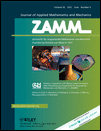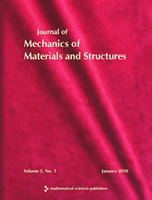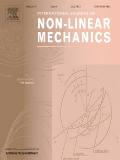
Moscow University Mechanics Bulletin
Scope & Guideline
Championing Knowledge in Mechanical Sciences
Introduction
Aims and Scopes
- Theoretical Mechanics and Mathematical Modeling:
This area encompasses the development and application of mathematical models to describe mechanical systems, including dynamics, elasticity, and fluid mechanics. - Computational Mechanics:
The journal highlights advancements in numerical methods and computational techniques used to solve complex mechanical problems, including finite element methods and computational fluid dynamics. - Applied Mechanics and Engineering:
Research focusing on practical applications of mechanics in engineering fields, including materials science, structural analysis, and mechanical systems design. - Interdisciplinary Studies:
The journal promotes interdisciplinary research that connects mechanics with other scientific fields such as biology, environmental science, and materials science, facilitating broader applications. - Innovative Materials and Structures:
Research on advanced materials, their mechanical properties, and applications in various engineering contexts, including nanomaterials and composites. - Nonlinear Dynamics and Oscillations:
This includes studies on the behavior of mechanical systems under nonlinear conditions, oscillatory motions, and stability analysis.
Trending and Emerging
- Hybrid and Advanced Energy Systems:
Recent papers emphasize the modeling and analysis of hybrid energy systems, particularly in combustion and propulsion applications, reflecting a growing interest in sustainable technologies. - Smart Materials and Structures:
There is an increasing focus on the behavior of smart materials, such as magnetizable elastomers and functionally graded materials, which are relevant for advanced engineering applications. - Robotics and Control Systems:
The integration of mechanics with robotics, particularly in motion control and navigation systems, is becoming a key area of research, indicating a trend towards automation and smart technologies. - Nonlinear Dynamics and Stability Analysis:
The exploration of nonlinear dynamics, especially in the context of stability and oscillatory behavior of mechanical systems, is receiving heightened attention, reflecting the complexity of real-world mechanical interactions. - Biomechanics and Biological Applications:
Emerging studies in biomechanics, particularly those linking mechanical principles with biological systems, illustrate a trend towards interdisciplinary research and applications in health and medicine.
Declining or Waning
- Traditional Fluid Mechanics:
There has been a noticeable decrease in publications focusing solely on classical fluid mechanics without incorporating modern computational or interdisciplinary approaches. - Static Analysis of Structures:
Research centered on static structural analysis has become less frequent, possibly due to a shift towards dynamic and time-dependent problems that reflect real-world applications more accurately. - Purely Theoretical Studies:
The journal appears to be moving away from purely theoretical explorations without practical applications, emphasizing instead studies that bridge theory and application.
Similar Journals

JOURNAL OF ELASTICITY
Exploring the Dynamics of Materials and MechanicsJOURNAL OF ELASTICITY is a prestigious peer-reviewed journal dedicated to the study and advancement of the field of elasticity and its numerous applications across various disciplines. Published by SPRINGER, and located in the Netherlands, this journal has been a key resource since its inception in 1971, providing critical insights and developments up through 2024. With a commendable impact factor and categorized within the Q2 quartile in areas such as Materials Science, Mechanical Engineering, and Mechanics of Materials, the journal maintains a significant standing in the academic community. Researchers and professionals will find a wealth of knowledge through advanced theoretical and experimental studies published within its pages, contributing to both foundational understanding and practical applications. While currently not an open access publication, the JOURNAL OF ELASTICITY remains an essential platform for innovative research and discussions that shape the future of mechanical sciences.

COMPTES RENDUS MECANIQUE
Advancing the Frontiers of Mechanics and Materials ScienceCOMPTES RENDUS MECANIQUE, an esteemed journal published by the Académie des Sciences, serves as a critical platform for cutting-edge research in the fields of mechanics and materials science. With an ISSN of 1631-0721 and an E-ISSN of 1873-7234, this open-access journal has gained visibility since its transition to open access in 2020, encouraging a broader dissemination of knowledge within the community. As of 2023, it holds a Q3 ranking in both the Materials Science (Miscellaneous) and Mechanics of Materials categories, according to category quartiles. Given its Scopus rankings—299th out of 398 in Mechanics of Materials and 360th out of 463 in General Materials Science—it provides valuable insights and advancements in these disciplines. Located in Paris, France, the journal caters to researchers, professionals, and students alike, showcasing a diverse range of studies and developments that push the boundaries of knowledge in mechanics. Through its accessible format, COMPTES RENDUS MECANIQUE not only highlights significant findings but also promotes collaboration and innovation across the global scientific community.

Theoretical and Applied Mechanics
Fostering Interdisciplinary Collaboration in Mechanics.Theoretical and Applied Mechanics is a premier open-access journal published by the Serbian Society of Mechanics, dedicated to advancing the fields of Applied Mathematics, Computational Mechanics, and Mechanical Engineering. Since its inception, this journal has provided a vital platform for researchers and practitioners to publish high-quality, peer-reviewed articles that contribute to our understanding of theoretical concepts and their practical implications in mechanics. With an ISSN of 1450-5584 and a growing international readership, Theoretical and Applied Mechanics aims to bridge the gap between theory and application, making significant strides in the engineering community. Although the journal is currently ranked in the Q4 category across its scopes, it encourages innovative research that fosters interdisciplinary collaboration. For those interested in exploring cutting-edge developments in the mechanics field, this journal offers an invaluable resource for researchers, professionals, and students alike.

Journal of Theoretical and Applied Mechanics-Bulgaria
Fostering Collaboration in Mechanics ResearchThe Journal of Theoretical and Applied Mechanics-Bulgaria, with the ISSN 0861-6663 and E-ISSN 1314-8710, is a pivotal publication in the field of mechanics, published by the esteemed BULGARIAN ACAD SCIENCES, INST MECHANICS. Based in Germany, this journal serves as a forum for researchers and practitioners to disseminate groundbreaking theories and applications in Computational Mechanics, Mechanical Engineering, and Modeling and Simulation. As of 2023, it is classified in the Q4 quartile for these categories, reflecting its emergence in the academic landscape, though it has room for growth in visibility and impact. The journal encompasses an ambitious scope aimed at fostering innovation and collaboration among academics, making it an invaluable resource for students and professionals seeking to stay abreast of emerging trends and methodologies in mechanics. Despite its current rank and percentile indicators in Scopus, the journal is committed to enhancing its reach and impact within the community through future editions converging from 2016 to 2024. With no open access options currently available, it emphasizes the importance of institutional subscriptions and academic partnerships to maintain its quality publication standards.

ZAMM-Zeitschrift fur Angewandte Mathematik und Mechanik
Unveiling Innovative Solutions in Applied Mathematics and Mechanics.ZAMM-Zeitschrift fur Angewandte Mathematik und Mechanik is a distinguished journal published by WILEY-V C H VERLAG GMBH, committed to advancing the fields of applied mathematics and computational mechanics since its inception in 1921. With a significant trajectory spanning nearly a century, this journal serves as a critical platform for the dissemination of high-quality, peer-reviewed research that encompasses theoretical and practical advancements in these disciplines. Currently holding a Q3 category in Applied Mathematics and Q2 in Computational Mechanics as per the 2023 rankings, ZAMM demonstrates its prominence with measurable impact in both fields, reflected in its Scopus rankings: 202 out of 635 journals in Applied Mathematics and 32 out of 89 in Computational Mechanics. Although it does not provide open access, ZAMM remains invaluable to researchers, professionals, and students seeking to deepen their understanding and contribute to the evolving landscape of mathematical applications in engineering contexts. Explore the latest insights and methodologies that push the boundaries of applied mathematics and mechanics by engaging with ZAMM’s comprehensive range of articles.

Journal of Mechanics of Materials and Structures
Innovating Insights in Applied Mathematics and Structural Mechanics.Journal of Mechanics of Materials and Structures, published by Mathematical Science Publishers, is a distinguished periodical in the field of Applied Mathematics and Mechanics of Materials. With the ISSN 1559-3959, this journal has been a pivotal platform since its inception in 2006, providing insights and advancements in the mechanics of materials and their structural applications. Operating out of the University of California, Berkeley, this journal not only boasts a respectable standing within its categories, ranking Q4 in Applied Mathematics and Q3 in Mechanics of Materials as of 2023, but it also serves a crucial role in fostering academic discourse among researchers, practitioners, and students alike. Although it does not currently offer open access, its contributions to the respective fields are invaluable, underscoring the relevance and importance of continued research in understanding material behavior and structural integrity. Whether investigating theoretical frameworks or engineering applications, the Journal of Mechanics of Materials and Structures remains an essential resource for anyone dedicated to the advancement of the science of materials and structures.

Journal of Computational Applied Mechanics
Fostering Innovation in Applied Mechanics ResearchJournal of Computational Applied Mechanics, published by UNIV TEHRAN, DANISHGAH-I TIHRAN, is an influential open-access journal that has been disseminating significant research findings since its inception in 2012. With a dedicated focus on the fields of Computational Mechanics, Mechanical Engineering, and Mechanics of Materials, this journal has garnered a Q3 ranking in multiple relevant categories as of 2023, indicating its burgeoning impact within the academic community. Although precise HIndex scores are currently unavailable, the journal's recognition is underscored by its Scopus rankings, placing it in the middle tier among its peers. The journal invites researchers, professionals, and students to contribute to and engage with the continually evolving discourse in applied mechanics, fostering innovation through the dissemination of quality research. As an open-access journal, it ensures that findings are readily accessible to a global audience, thereby enhancing collaboration and knowledge sharing in the scientific community.

Izvestiya of Saratov University Mathematics Mechanics Informatics
Bridging Disciplines: Mathematics, Mechanics, and InformaticsIzvestiya of Saratov University Mathematics Mechanics Informatics is a prominent open access journal published by Saratov State University, focusing on the interdisciplinary fields of mathematics, mechanics, and computer science. Established as an accessible platform for researchers since 2007, this journal fosters the dissemination of innovative research and advancements in computational mechanics, general mathematics, and mechanical engineering among others. Although currently categorized within the Q4 quartile rankings in various domains, including Computational Mechanics and Mechanics of Materials, it serves as a crucial resource for professionals and scholars aiming to explore emerging trends and methodologies. Operating out of Saratov, Russian Federation, this journal not only contributes to local academic discourse but also holds international relevance, welcoming submissions that push the boundaries of traditional research. Researchers, professionals, and students alike are encouraged to engage with the wealth of knowledge presented within its pages, reinforcing the journal’s role as a vital component in the ongoing development of these scientific fields.

INTERNATIONAL JOURNAL OF NON-LINEAR MECHANICS
Connecting Theory and Application in MechanicsWelcome to the International Journal of Non-Linear Mechanics, a premier publication dedicated to advancing the understanding of non-linear behavior in mechanical systems. Published by Pergamon-Elsevier Science Ltd, this esteemed journal has been an influential platform since its inception in 1966 and continues its rigorous exploration of specialized topics until 2024. With a strong focus on applied mathematics, mechanical engineering, and mechanics of materials, it holds an impressive Q1 ranking in both mechanical engineering and mechanics of materials, and a Q2 ranking in applied mathematics, underscoring its significance in these fields. Notably, it ranks 81st out of 635 in Applied Mathematics, highlighting its vital contribution to the literature. The journal's commitment to quality research is reflected in its indexing in Scopus and its prominent impact within the academic community. Although not an open access journal, it remains accessible to researchers and professionals seeking cutting-edge innovations and breakthroughs in non-linear mechanics. We invite scholars, practitioners, and students alike to engage with the pivotal research published in this journal as they advance their own works in the dynamic landscape of engineering and applied sciences.

Journal of Theoretical and Applied Mechanics
Unlocking Knowledge in Mechanics for AllJournal of Theoretical and Applied Mechanics, published by the Polish Society of Theoretical and Applied Mechanics, stands as a leading platform for disseminating cutting-edge research in the realms of theoretical and applied mechanics. With its ISSN 1429-2955 and E-ISSN 1429-2955, this Open Access journal has been fostering academic dialogue since 2006, making knowledge readily accessible to researchers and practitioners alike. Based in Warsaw, Poland, the journal encompasses a wide breadth of topics within mechanics, appealing to a diverse readership including researchers, professionals, and students. The journal's current Scopus ranking places it within the 30th percentile of the field, emphasizing its relevance and contribution to the discipline. As it converges from 2007 to 2024, the Journal of Theoretical and Applied Mechanics is pivotal for those seeking to advance understanding and innovation in mechanical engineering and mathematics, making it an essential resource for anyone involved in these critical areas of study.